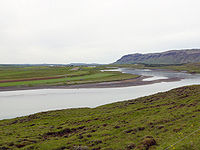| This article does not cite any sources. Please help improve this article by adding citations to reliable sources. Unsourced material may be challenged and removed. Find sources: "Hvítá" Árnessýsla – news · newspapers · books · scholar · JSTOR (December 2009) (Learn how and when to remove this message) |


Hvítá (Icelandic [ˈkʰviːtˌauː] , "white river") is a river in Iceland that begins at Hvítárvatn glacier lake on Langjökull glacier in the highlands of Iceland at 64°37′N 19°50′W / 64.617°N 19.833°W / 64.617; -19.833. The river flows for 40 kilometres (25 mi) before dropping down into a narrow gorge at Gullfoss waterfall.
Thereafter, the river flows between Biskupstungur [ˈpɪskʏpsˌtʰuŋkʏr̥] and Hrunamannahreppur districts. Here, Hvítá combines with three other rivers: Tungufljót [ˈtʰuŋkʏˌfljouːt], Brúará, and Stóra-Laxá [ˈstouːra-ˌlaksˌauː], doubling the volume of the river. It proceeds to run through the flatlands near Grímsnes [ˈkrimsˌnɛːs] and behind Ingólfsfjall mountain. Just north of Selfoss town, it meets Sog River where it becomes Ölfusá as it flows into the Atlantic Ocean.
Because of danger of flooding, especially during winter, Hvítá has a reputation of being the most dangerous river in Iceland.
Organised rafting excursions take place on parts of the river. The river is bridged at 4 locations, thrice at the lowland and once near the source in the highland where it is only open over the summer.
See also
This article related to a river in Iceland is a stub. You can help Misplaced Pages by expanding it. |